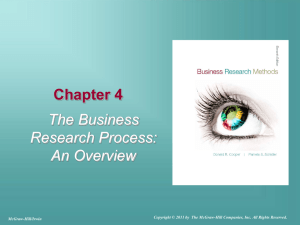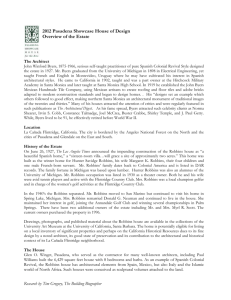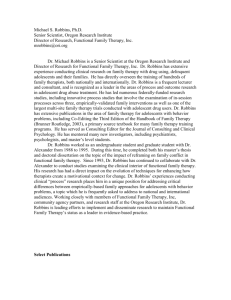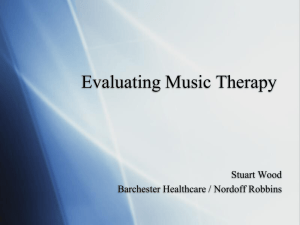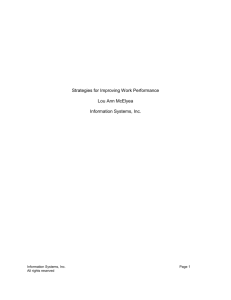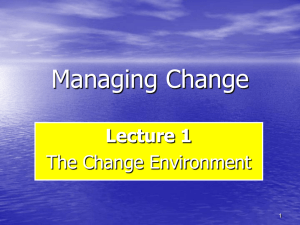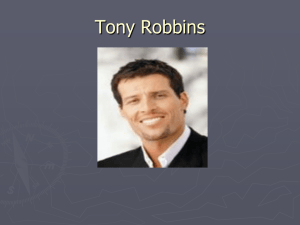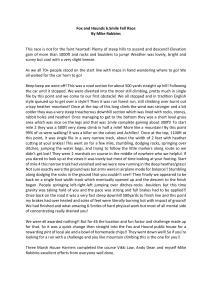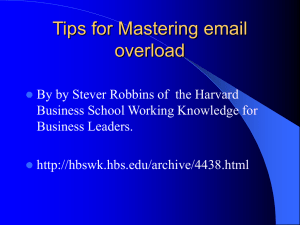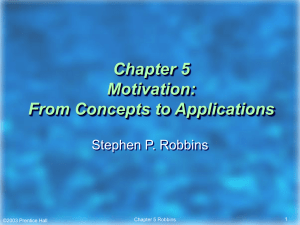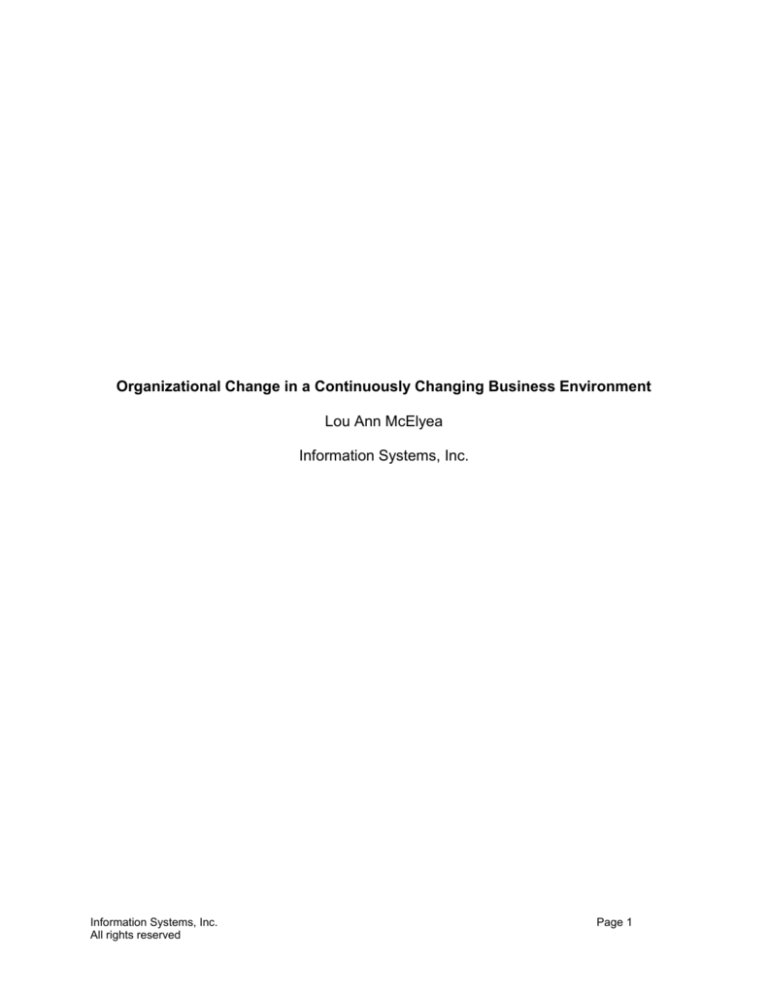
Organizational Change in a Continuously Changing Business Environment
Lou Ann McElyea
Information Systems, Inc.
Information Systems, Inc.
All rights reserved
Page 1
Abstract
In this paper organizational change and the relationship of resistance to change,
innovation, organizational learning and stress in a continuously changing organizational
environment will be examined.
Information Systems, Inc.
All rights reserved
Page 2
Changes in the business environment require changes in organizational and
individual behavior and causes individual stress. Some of the reasons for change
include globalization, internet growth, rapid technology advancements, business
process reengineering, rise of the information economy, flattening of organizational
structures, outsourcing (Laudon & Laudon, 2012), increased use of teams,
empowerment of teams and individuals, political unrest, terrorism, social trends, multicultural workforce and increased competition (Robbins, 2005). How the organization
deals with the changing business environment determines their success or failure.
In this environment there is organizational and individual resistance to change.
Robbins describes several sources of resistance to organizational change.
Structural inertia is a built-in mechanism to produce stability and serves as a
counterbalance to change to sustain that stability (Robbins, 2005). This could be
evidenced through changes in processes and relationships brought on by globalization.
Limited focus of change causes limited changes in subsystems to be nullified by
the system as a whole (Robbins, 2005). This constraint supports the case for enterprise
process reengineering.
Group inertia acts as a constraint where group norms prevent individuals who
support change from changing their behavior (Robbins, 2005). The group might
pressure others to avoid adopting technological changes through fear.
Threat to expertise of specialized groups may be the result of changes in
organizational patterns (Robbins, 2005). This is particularly true in the case of
information systems outsourcing.
Information Systems, Inc.
All rights reserved
Page 3
Threat to established power relationships is brought about by any redistribution
of decision making (Robbins, 2005). The increase in empowerment of employees and
teams can change established power relationships.
Threat to established resource allocations to groups who control large numbers
of resources (Robbins, 2005). The use of teams may be a threat.
Overcoming resistance to change requires considerable effort and senior
management support. Robbins lists six tactics for overcoming resistance: education and
communication, participation, facilitation and support, negotiation, manipulation and
cooptation, and coercion. Of these six tactics, management experience has proven that
education and communication are the most critical. Most employees will support change
if they understand the reason for the change. Communication should be direct, honest
and often to establish management-employee trust and gain employee support. Most of
us have a greater fear of the unknown than we do of any known risk. Education and
training play a key role in breaking down resistance to change. This is particularly true
where technology is being implemented as part of the change.
Because constant change is just part of the business landscape today, most
successful organizations have become learning organizations. Globalization and
technology have caused continuous learning to be part of the organizational culture.
In “Communicating Change” the authors point out that poor communication can
severely limit productivity gains when new technology is implemented causing the
organization to fall short of the projected return on investment. They go on to say that
the biggest gains on a capital investment may not be the “thing” itself but the learning
that takes place as a result of the implementation of the “thing” (Larkin & Larking, 1994).
Information Systems, Inc.
All rights reserved
Page 4
Maurer discusses three levels of resistance to change. The first level is based on
information, the second level is emotional and the third level may be resistance to the
manager which suggests people may resist any change this manager brings forward
(Maurer, 2000). All three levels require effective communication and education to break
down the resistance.
A learning organization is defined as an organization that has developed the
continuous capacity to adapt and change. Managers can transform their organization
into learning organizations by establishing a strategy for change, innovation and
continuous improvement, flattening the organizational structure and reshaping the
organizational culture (Robbins, 2005).
Innovation is simply defined as “a new idea applied to initiating or improving a
product, process or service”. All innovations involve change (Robbins, 2005).
Change is both a routine and a novel fact of organizational life. Most
organizations have developed well defined processes to manage routine change. Novel
changes do not have established processes or procedures, are more difficult to manage
and require organizational innovation. A conclusion that can be drawn suggests that a
learning organization fosters innovation and may actually be necessary (Van De Ven,
1995).
In an article entitled “Innovation All the Time” the author suggests that is the way
creative industries work but businesses in more “serious” industries study and analyze
innovative opportunities rather than just letting the innovation flow. He points out that
many organizations have outsourced their creative work because it is considered part of
production. This inhibits innovation because the tangible result is produced by someone
Information Systems, Inc.
All rights reserved
Page 5
outside the organization. He also suggests that accepted group norms keeps
employees busy but achieving little progress and that the educational system places the
importance on the intellectual rather than tangible innovative results (Conley, 2006).
This is what Robbins refers to as group inertia (Robbins, 2005).
In the article, “Happiness and the Art of Innovation,” the author states the number
one way to make employees more innovative is to help them achieve personal
happiness. To be happy they need to be fully engaged. The manager needs to help
them establish the balance between an assignment that is too complex or one that is so
routine that it is boring (Rodriguez, 2006). Both complexity and boredom can cause
stress for the individual (Koslowsky, 1998).
Stress is associated with constraints and demands and there is uncertainty over
the outcome and the outcome must be important (Robbins, 2005). The consequences
of stress for the individual can be physiological, psychological or behavioral. Some
potential sources of individual stress are family or economic problems and personality.
Sources of organizational stress are task, role or interpersonal demands and
organizational structure, leadership or organization life cycle (Robbins, 2005). Stress is
experienced by individuals but can have a major impact on the organization.
Some of the steps individuals can take to reduce stress are using time
management techniques, increasing physical exercise, relaxation training or expanding
their social support network. Strategies management should consider are:
Improved personnel selection and job placement
Training
Information Systems, Inc.
All rights reserved
Page 6
Realistic goal setting
Redesigning jobs
Increased employee involvement
Improved organizational communication
Offering employee sabbaticals
Establishing wellness programs (Robbins, 2005)
Strategies that can be applied to reduce stress when it is caused by changes
are:
Open, informative communication
Greater involvement in the decision-making process
Preparing the employee for the change through training programs, role
playing and job rotation
Implementing change slowly
Feedback, reinforcement and rewards
Using a positive approach, enumerate positive benefits and provide
evidence change is necessary and beneficial (Connor & Worley, 1991).
Training is mentioned as a means to reduce stress, gain acceptance for change
and foster innovation. In a learning environment, the negative effects of change
can be reduced. Change, learning organizations, innovation and stress are very
much related. Managed appropriately, they can all be used constructively in the
organization.
Information Systems, Inc.
All rights reserved
Page 7
References
Conley, Chris (2006), Innovation All the Time, Business Week Online, 9/19/2006, 14,
Retrieved 10/2/2006 from
http://web.ebscohost.com.proxy1.ncu.edu/ehost/delivery?vid=36&hid=109&sid=b
92992de...
Connor, Patrick E., Worley,Charla Hart (1991), Managing Organizational Stress,
Business Quarterly, Summer91, Vol. 56 Issue 1, 61, Retrieved 10/2/2006 from
http://web.ebscohost.com.proxy1.ncu.edu/ehost/delivery?vid=57&hid=109&sid=b
92992de...
Koslowsky, Meni (1998), Modelling the Stress-Strain Relationship in Work Settings,
London, GBR: Routledge, Retrieved 10/2/2006 from
http://site.ebrary.com/lib/ncent/Doc?id=10070469&ppg=41
Maurer, Rick (2000), What Blocks Support? Journal for Quality and Participation,
May/June2000, Vol. 23 Issue 3, 47, Retrieved 10/2/2006 from
http://web.ebscohost.com.proxy1.ncu.edu/ehost/delivery?vid=18&hid=109&sid=b
92992de...
Rodriguez, Diego (2006), Happiness and the Art of Innovation, Business Week Online,
3/6/2006, 12, Retrieved 10/2/2006 from
http://web.ebscohost.com.proxy1.ncu.edu/ehost/delivery?vid=45&hid=109&sid=b
92992de...
Van De Ven, Andrew H., Managing the Process of Organizational Innovation In Huber,
George P., Glick, William H. (1995), Organizational Change and Redesign, New
York, Oxford University Press
Information Systems, Inc.
All rights reserved
Page 8
Laudon, Kenneth C. & Laudon, Jane P., (2006), Management Information Systems,
Managing the Digital Firm, Upper Saddle River, New Jersey, Pearson, Prentice
Hall
Larkin, TJ, Larkin, Sandar (1994), Communicating Change, Winning Employee Support
for New Business Goals, McGraw-Hill, New York
Robbins, Stephen P. (2005), Organizational Behavior, Upper Saddle River, New Jersey,
Pearson, Prentice Hall
Information Systems, Inc.
All rights reserved
Page 9

